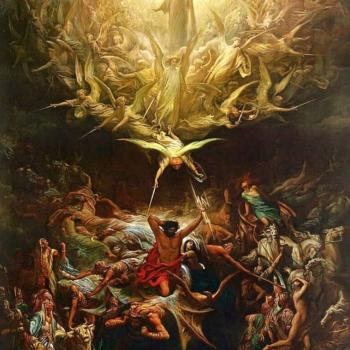I am not saying with this article that there are only two great Christmas songs. Nor that these two songs are objectively the greatest (although I do believe that beauty is objective). Rather my claim is that theologically and historically-speaking, these two songs are always consider among the great hymns of Christmas. And while I cannot analyze their melody in the form of an essay, which obviously is one half of what contributes to their greatness, I can analyze the other half: the lyrics. But first, a bit about why older songs are, objectively speaking, greater than many, or most, newer ones.
Why Old Hymns Are Better Than New
In an article from earlier this year, art critic, Ted Gioia, rightly laments the slow degradation of the arts into what he calls “Addiction.” Without rehearsing the entirety of the article’s argument, which is compelling, Gioia basically shows how true art has degraded over time: first into Entertainment, then into Distraction, and finally Addiction. A large reason for this decay is technology, but there are other factors.
In short, first, there was actual art, a domain of human culture that made demands on both the creative artist and the recipient of the work of art. Art was complex, filled with thought, crafted with care, hallmarked by expertise in some concrete discipline or skill. It took time and effort to paint, to play an instrument, to act and to sing. And, there was a goal, a telos, to aim for. For every artistic endeavor possessed a form, but a form that could always be bettered in some way, leading to art as a means not only to making a product, but art as a means for the formation of the artist herself.
However, at some point Art began to compete with Entertainment, its less complex and less demanding bastard child. Entertainment was a means for the man busied by modernity to relax, to stop thinking, and to shut down and tune out. It was, to paraphrase a famous piece of cinematic Entertainment, simply “to be entertained.”
However, according to Gioia, even Entertainment is now dying, or, perhaps already dead. Entertainment has been replaced by the techno-world of distraction: movies are replaced by Tik Tok videos, essays by memes and slogans, speeches by soundbites. Finally, Distraction ends in Addiction, since both are literally grounded in dopamine rushes that the brain receives as we are hit with an endless stream of novel, albeit relatively useless, information. It is nothing more than raw stimuli.
Summing up the process, Gioia says:
Even the dumbest entertainment looks like Shakespeare compared to dopamine culture. You don’t need Hamlet, a photo of a hamburger will suffice. Or a video of somebody twerking, or a pet looking goofy.
Instead of movies, users get served up an endless sequence of 15-second videos. Instead of symphonies, listeners hear bite-sized melodies, usually accompanied by one of these tiny videos—just enough for a dopamine hit, and no more.
But, what has this to do with Christmas music?
Music is one of the main victims of this historical decline in the aesthetic realm. This degradation of our aesthetic production, as well as our sensibilities to the aesthetic, has also affected our Christian, and our Christmas, music. Ask any Christian worship leader worth their salt what is the main difference between the old hymns and the newer “worship” songs and they will tell you: complexity and depth of both score and lyric. Since I cannot deal with the complexity of the music, I will turn instead to the depth of the lyric.
Theologians have long recognized that when it comes to how we speak, or sing, about God, our merely human expression will never be deep enough to fully articulate God. Still there are ways to speak of God, and of man as well, that do more justice to their subjects than others. What Gioia is lamenting in his piece on art in general, is a lament we can also raise with regard to Christian art, and, in this case, to Christian music. More precisely, we can relate this to Christmas music. Christmas music, like any other expression, is an attempt to describe something. In this case, the incarnation of Christ. Even the most atrocious Christmas songs ever written, namely, Paul McCartney’s “Wonderful Christmastime,” and Mariah Carey’s “All I Want for Christmas is You” are saying something about Christmas. They are just saying it very badly. Very badly.
In contrast, when we hear these two greatest Christmas songs, and listen carefully to their lyrics, we are struck by something grand, something profound, something holy. They are using language and melody to say something about Christmas that these other songs are clearly not. At least we should recognize this to be the case. If we do not, then I fear our aesthetic sensibilities have degraded alongside the artistic project itself. I further fear that this probably is what is happening. I can only hope, then, that this essay will at least move the needle back, even a bit, to us recognizing that these next two songs are, if not clearly superior, at least much better than the two just referenced.
Christmas Song #1: “What Child is This?”
For the full text of our first greatest Christmas song (now there is a good misuse of English grammar if ever there was one), see here. The author, W. Chatterton Dix, unlike most hymn writers was a layman, not clergy. But like many in the 19th-century in England, he was well-versed not only in music but in theology. Here are the three refrains and chorus:
1 What Child is this, who, laid to rest,
On Mary’s lap is sleeping?
Whom angels greet with anthems sweet,
While shepherds watch are keeping?Chorus:
This, this is Christ, the King,
Whom shepherds guard and angels sing:
Haste, haste to bring Him laud,
The Babe, the Son of Mary!2 Why lies He in such mean estate,
Where ox and ass are feeding?
Good Christian, fear: for sinners here
The silent Word is pleading.[Chorus]3 So bring Him incense, gold, and myrrh,
Come, peasant, king to own Him.
The King of kings salvation brings;
Let loving hearts enthrone Him.[Chorus]
Anyone who has listened to a powerful male, or female, voice belt out the first line of the Chorus, “This, this is Christ, the King,” will know how the melody and lyrics combine to proclaim a truth that is not only true objectively, namely, the Jesus Christ is the King of the Universe (being, after all, its Maker); but that is also subjectively true for each man and woman who hears it. The power of the lyric when sung with force speaks to one of our deepest needs: the innate longing and desire to actually have a king. All of us, even the most bitter and hardhearted, at one time or another realizes we need a king to rule over us. Why? Because in moments of brutal honesty, in the silent hours of the early morning, or late at night before bed, we realize how fragile, how flawed, and how finite we are. We know we are helpless. And we know we are not kings, let alone god, and this regardless of how much power, prestige, or online “influence” we think we have.
This longing for a king to rule over us is present in all our great literature. Not because we don’t want to do things for ourselves, nor because we want to be told what to do all the time. No. The reason why we resonate with Arthur or Aragorn is because we long to worship something, or more likely someone, who is greater than us. It is also why we often give ourselves over to leaders who appear great, or charismatic, or powerful. It is also why we often wind up later being let down, perhaps all the way down, even unto tyranny or madness.
But the questioning of the opening stanza, the asking of “what child this is” is the natural and universal question of hope. A question asked by all men, everywhere, throughout time: could there be a child, one born that becomes a true king, a monarch that is both in nature, and act, qualitatively different from all others who have sat in the seat of power and attempted to fulfill the role of sovereign? The answer, both lyrically and metaphysically, and historically, is: “yes, there is!” And, when we recognize that this king is so different, both in kind and degree, from any human king, or chancellor, or prime minister, or president, we begin to hope that this, one of our most existential yearnings, may actually find its long sought after object of faithful obedience. A king, a real King, who will not, nor cannot, let us down.

Christmas Song #2: O Holy Night!
Unfortunately, human kings fail us. Those kings are often not actual kings: they can be CEOs, politicians (obviously!), coaches, commanders, parents. However, since this profound desire to worship one greater than us, but who is also Good, cannot be realized by any human agent outside ourselves, it is often to ourselves that we turn to find fulfillment. It is in this turning in on ourselves, or, as Luther called it, “homo incurvatus in se” (man turned in on himself) that we begin to worship and honor just that: our self.
This turning in on the self further hardens a heart already stained with the macula of sin. It is what prevents us from declaring, from proclaiming along with the poet that this is Christ our King. That is where our next greatest Christmas song picks up. Because one corollary of our resistance to worship the true King, to humble ourselves before His presence, is the pride that wells up in us at the thought of having to relinquish the self-worth we believe to have constructed on our own. You know this cultural mindset for it is ubiquitous: the “be true to yourself” idolatry of our age (and, in fact, of all ages).
But the worth that we need, the dignity we seek, cannot actually be generated by ourselves. We need to feel our own worthiness from without, no matter how hard we try to build up our own mechanisms of value from within. The song that most powerfully speaks to both our need for King, and our need for the King’s favor is O Holy Night!
Originally a French poem by Placide Cappeau, it was John Sullivan Dwight who put together the English verse. Although a Unitarian, Dwight’s translation of Cappeau captured the theological truth of the incarnation of Christ, which allows all orthodox Christians the joy of singing it each year:
1 O holy night! the stars are brightly shining;
It is the night of the dear Savior’s birth.
Long lay the world in sin and error pining,
Till He appeared and the soul felt its worth.
A thrill of hope- the weary world rejoices,
For yonder breaks a new and glorious morn!
Fall on your knees! O hear the angel voices!
O night divine, O night when Christ was born!
O night, O holy night, O night divine!2 Led by the light of faith serenely beaming,
With glowing hearts by His cradle we stand.
So led by light of a star sweetly gleaming,
Here came the Wise Men from Orient land.
The King of kings lay thus in lowly manger,
In all our trials born to be our Friend.
He knows our need— to our weakness is no stranger.
Behold your King, before Him lowly bend!
Behold your King, before Him lowly bend!3 Truly He taught us to love one another;
His law is love and His gospel is peace.
Chains shall He break, for the slave is our brother,
And in His name all oppression shall cease.
Sweet hymns of joy in grateful chorus raise we;
Let all within us praise His holy name.
Christ is the Lord! O praise His name forever!
His pow’r and glory evermore proclaim!
His pow’r and glory evermore proclaim!
To expand on the rich theology of these lyrics would warrant a whole other article. Everything is here: the sinfulness and futility of the world, the thrill of hope for a cosmic inbreaking into that world, the world laying itself prostrate to its Creator, the law of Love that Christ teaches mankind, and the true power that is the divine Goodness. However, the one line that usually causes even the most stoic among us to break down inside is this one: “Till He appeared and the soul felt its worth.” This line alone has caused the hard heart of many to melt away into a heart of flesh (Ezek 36:26). For what we all know intuitively is that our souls need to feel the weight and significance of their worth. And we need to know that today, at Christmastime in America in 2024, more than ever! In a culture that is dead and dying, and almost eager to cease to exist, we cannot be too zealous in the proclamation of the worthiness of each and every soul.
However, as the song goes on, it is only through the falling on our knees, only in the adoration of the King, that we can finally recognize the gravity of our own worth. There is no other way, and to no other place, and to no other Person we can go other than Christ, who we at one and the same time serve with all our soul, and, in so doing, have our soul be so elevated as to become like royalty. It is only in and through the birth of Christ, that these two most profound desires of men, to be like a king, and to serve the King, can meet. It was this idea, this reality, that C.S. Lewis reimagined in his most famous work of fiction: The Chronicles of Narnia, where the sons of Adam and daughters of Eve are made kings and queens in the service of Aslan, the King of Kings.
And that is why we celebrate Christmas, and it is why these two greatest songs of the Christmas tradition are still sung today, in different ways, and in different voices, but always with the same message: the Gospel of Peace that was brought into the world on that most holy night when our King was born.
Merry Christmas!
* Note, there really aren’t only two great Christmas songs. There are roughly 14 : Adeste Fideles, Hark the Herald Angel Sings, Angels We Have Heard on High, Joy to the World, Away in a Manger, It Came Upon a Midnight Clear, Good Christian Men Rejoice, O Come O Come Emmanuel, Go Tell it On the Mountain, O Little Town of Bethlehem, In Dulce Jubilo, Silent Night, What Child is This, and The Little Drummer Boy.














